[Editor’s note: This is the first article by new BikePortland.org contributor Elly Blue. Let’s give her a nice, warm welcome!]
Last month, I dropped by Last Thursday on Alberta to visit local artist Carye Bye. I was pedaling pretty slowly, gawking at the art, the oddly-dressed hipsters, the musicians, and the improbable bikes when someone in a car behind me honked their horn and I reluctantly sped up.
Then, Someone on a bike ahead of me swerved away from a car nosing its way through the intersection.
Carye was doing a brisk trade, but just starting to enjoy herself. It’s becoming increasingly stressful to set up her table, she said, due to competition for sidewalk space. Later, I walked a few blocks down the street and back, and could barely move through the claustrophobic crush of people squeezed together on the narrow sidewalk.
I had a vision—as I got back on my bike and cut down 29th—of the length of Alberta closed to cars, and opened up to people walking, biking, skateboarding, and rollerblading. I imagined more space for artists to display their wares, for people to roam in safety, and room for bigger, bolder happenings, like fire dancers, chalk drawings, and other creative endeavors.
Taking cars off the street so that you can make a fair or a party even more festive and safe doesn’t sound like a radical idea, and that’s exactly why it’s one of the most revolutionary possibilities out there.
Any summer weekend, you’re likely to happen upon several official or unofficial street closures for neighborhood block parties or
festivals. Anyone can apply for a street closure permit (here’s more information on the permit process).
The Mississippi Street Fair and Free Geek’s Geek Fair (on July 15th) are both carfree events. The Mississippi event even uses this as a selling point on their poster saying, “People only, closed to cars all day.”
Wouldn’t it be great if we had more carfree events?
Why shouldn’t the popular Peacock Lane holiday lights display have one night when you can go see them by foot and bike—but not by car?
Portland has had two Car Free Day street fairs in the past, but this year organizers decided to focus their efforts on more carfree events throughout the city instead of a one-day fair.
If we can educate the the community on the benefits of carfree days and the process of street closures, then every day could become Car Free Day—without the potentially alienating name.
Or maybe—this is another dream, but one I’m convinced can become reality—what if we could have one day where all of Portland could be freed from the traffic, smells, dangers, and noise created by private cars?
Bogota, Columbia under the visionary leadership of former mayor Enrique Penalosa has done it every year since 2000 to widely popular acclaim.

Photo: Institute for Transportation and Development Policy
It sounds counterintuitive, but when was the last time you rode your bike after 3am or before 7am? The roads are free, easy, open. People wave to each other, say hi, nod over coffee.
Even better, think back to the yearly snowstorms that essentially do the same thing in Portland. Remember how festive it is, with people walking to their local shops, cafes, and bars, greeting each other in the street, chatting with their neighbors, usually strangers, about the weather and their city? Imagine that, but without the inconveniences created by having no warning, or by dangerous road conditions. If we had months or weeks to make other arrangements for getting to work and running vital errands, a snow day would be a real holiday—the kind of day that builds community and makes people feel happy.
When you think of it that way, it only makes sense to try to and create more carfree days in Portland.
If you’d like to get involved in making more carfree events happen in Portland, I’m putting together a working group of like-minded folks to make this happen and I’d love to have you join us. Read more here or get in touch with me directly at eleanor[dot]blue[at]gmail[dot]com.
For more carfree information check out these links:

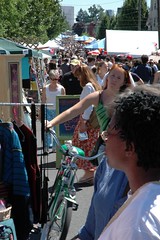
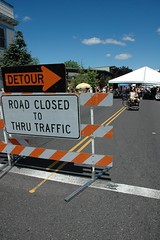
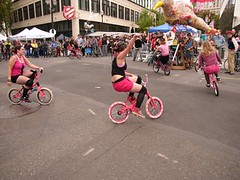
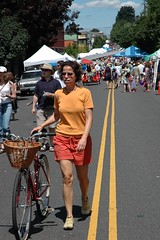

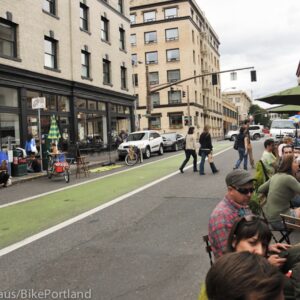
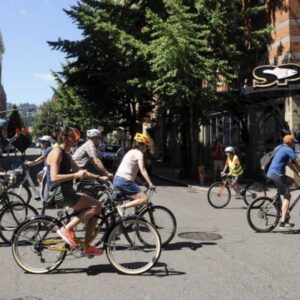

Nice article Elly, So easy to see more temporary happy carefree zones in our future. Then one day, one is made permanent, then another.. I’d like to learn more abut what The City’s policy position is.
Welcome Elly! Let me know what Portland Transport can do to help.
Car free events? Why not car free entire streets?
I have traveled a bit and found that some of the best urban places on the planet are car free streets crowded not with moving steel, but with people – shoppers, walkers, strollers, musicians, vendors, etc.
Portland has a few downtown streets where it would be great. SW Park and SW 9th between and Salmon already has a bit of a Europeon feel. Remove the traffic, open up some sidewalk cafes, and it would compete with Paris! Another good place for no cars and even an overhead arcade would be SW Ankeny between 4th and Front. It would easily spill over into the Saturday Market area (which would be an everyday street market in any other part of the world).
Come to think of it, even Las Vegas has a fantasy land car-free downtown area completely covered by a high arcade. It covers several blocks and is arguably the best part of that city.
Excellent article Elly!
What about a day of coordinated neighborhood block closures? If, say, every other block were closed and the neighbors hosting the block parties encouraged cycling visitors, one could ride for miles with little or no interuption. The blocks in between would become quieter too, since the motorist is always looking for a straight, uninterrupted path to travel.
There has been a heated debate going on for a year about Last Thursday with regard to the idea of street closure. Apparently the city has argued that the busses are the main reason for Alberta Street to remain open during Last Thursday due to the fact that adjacent streets are too narrow for detour routes. During the Art Hop busses had to wait for the parade to go through.
The information I got about this debate was second-hand. For the store owner’s viewpoint, a good person to talk to would be Allan Oliver owner of Onda Gallery: http://www.ondagallery.com
Thanks for the tip about Last Thursday!
The permanent street closure idea is an excellent one. I forgot to mention a recent article in the Oregonian (I think), suggesting that business owners on SW Ankeny are primed to have their street be bike and ped only. Not a bad one to start with — it is very narrow and doesn’t see much auto traffic.
There’ll be a meeting in SE this Wednesday at 7pm to talk about ideas like this and start handing out tasks toward hopefully making them happen. Email me if you’d like to join in the fun.
Elly,
You mentioned the car-free day in Bogota. In addition to that one day event, they also close over 100 kilometers of streets every Sunday to cars. They shut down one side of divided roads and completely close a bunch of others to create a huge network of streets and paths for pedestrians and cyclists (and any other non-vehicle traffic). I was there visiting some family on one of these days, and it is amazing to see thousands of people out exercising on major roads and highways, completely closed to cars. It is like that every Sunday for several hours. They are really onto something good down there.
I like the ideas you present, but maybe we should be thinking much bigger. If we followed Bogota’s example, it would be like doing Bridge Pedal every weekend here in Portland, plus closing Broadway, Burnside, Hawthorne and MLK/Grand to traffic. I think that would be pretty darn cool.
One addition to my previous post. The weekly street closure event in Colombia is called “Cyclovia”. It was started in Bogota, but is now copied in many other cities around the world. Cyclovia means “life to the street”
It sure sounds like a beautiful idea to cruise casually down a wide open, car-free street on a hot summer night and watch the crowds at a festival, while not being stuck in their midst. But is that really what’s going to happen? If the street were closed, do you think all of those pedsetrians would stay on the crowded sidewalk? Do you think the artists would stay there with the wide open street right in front?
As soon as the street is closed, everyone and everything on the crowded sidewalks will fill up all of that wonderful empty space, and you STILL won’t be able to ride your bike through the festival without someone getting annoyed at you. Only, instead of drivers, it’ll be pedestrians.
The other car-free events you mentioned are tiny, once-a-year festivals that are no more that a couple of blocks long and draw relatively small crowds. Last Thursday is monthly and takes place on a main transportation artery over about 15 or so blocks. What a mess to close it down, a giant inconvenience to the neighbors who live there and the people just riding the bus through, all for the sake of “tourists” to the area. And all for the sake of an idealistic daydream born out a knee-jerk reaction against cars and drivers.
One final point: one of the big reasons people even go to the festival is for those over-crowded sidewalks. Whether they realize it or not, they go to see who else is there, and the overstimulating crush of humanity is half the fun. We go to see each other, and to be close to each other. If you spread it out, it’ll just be LESS interesting, not more.
John, it doesn’t sound like you’ve been to a Car-Free Day Street Fair before. At the 2003 / 2004 street fairs, the fair was plenty navigable on a bike. Also, having people spread out more actually facilitated people-watching in a way, because fewer faces were hid behind other people in a crowd. At a well-executed street fair, there is plenty of stuff / activity to fill up the space, it does not feel barren.
I think your complaints are unnecessary nit-picking.
This article has been featured in the Carnival of Community Campaigns at HumanTide
Wow, thanks for all the comments.
Dave: I completely agree, let’s think even bigger. Colombia is an incredible example. A group in Australia just put on their first Cyclovia and it was a huge success. Why not Portland?
John W: Thanks for the critique. You are absolutely right-on with most of your concerns, and I’m sure they will be voiced by others before too long. I’m hoping that we can help neighborhoods close streets to cars on an experimental basis, but only *if they want to*.
Maybe a car free last Thursday would dilute the event too much, or be more disruptive than productive, but we’ll never know until it’s been tried once. However, that’s ultimately up to the community.
I would like to argue, though, that getting more pedestrians into the street is the best possible scenario, even (or especially) if it means slowing bikes down on that street. Bikes, like cars, can take alternate routes, but pedestrians are the life of the street and we should be thinking of them most and first.
Hi Elly –
Please count me in on your carfree stuff, and thanks for working on it.
I tend to be impatient with little steps, but acknowledge that this is the only way forward, most of the time. A year ago I wrote this: http://todd.cleverchimp.com/blog/?p=21 . Nothing came of it, as attendees couldn’t quite agree on plans that were (a) reasonably achievable and (b) meaningfully bold.
I think peak oil will make carfree living a natural choice for a critical mass of Portlanders over the next decade or two, and help return whole districts to their original carfree design, not so much by activism as by economic compulsion. I see activist efforts in the interim as a way to help people envision inevitable changes as positive, rather than as the real drivers of change. I think maybe I will live to see any use of private motor vehicles much heavier than their payload come to be considered so wantonly wasteful and dangerous as an incitement to mob violence.
Something we’d be interested in is a way for property owners to assert their “carriage rights” by placing semi-permanent planters or other car-size items in the street adjacent to their property, to reclaim the street for nonautomotive uses, slow down flow, etc. As far as I know, it’s illegal for us to try to do this; the only way we can deter parking in the spots we have some legal responsibility for is to park cars there ourselves! If 2-3 people would do this per block, the resulting constriction of the roadway and curtailment of “free” parking could tilt things a good way.
Another stratagem might be for Portland to offer incentives to eliminate curb cuts, driveways, and garages added to homes built originally without them (the large majority), as a way to get back the gardens or habitable outbuildings they replaced. Could be spun as a runoff mitigation thing, a green thing, a historic restoration thing, etc. It’s kind of silly that we’re compelled by code to preserve the horse tie-up rings in the curb in front of our place (‘preserves historic character’), unless we want to put in a driveway — then it’s no problem to cut the curb and effectively extend the motorway across the sidewalk.
As a kid in the ’60’s and ’70’s, I spent summers on the New Jersey Shore. There was a town there, Spring Lake, that was closed to cars on Sunday. If I recall my history, the town was founded and owned by the Methodists, so the closure was mostly a religious thing (day of rest and all that) but it made it a great place to be. It was that way the last time I was there in the late ’80’s. My Joisey relatives said that as the town has moved away from it’s Methodist roots, the government caved to the pressure to eliminate the no-car Sundays. Darn.
“What a mess to close it down, a giant inconvenience to the neighborswho live there and the people just riding the bus through, all for the sake of “tourists” to the area. And all for the sake of an idealistic daydream born out a knee-jerk reaction against cars and drivers.”
John,
If you went to the most recent Last Thursday on Alberta, we were clearly in different places at different times. What you describe above, is exactly what was already happening.
I saw busses and cars idling in a sea of pedestrians and the biking was a bear in some places. Spectators at the Clown House filled the entire intersection. People were walking down the middle of the street because they
couldn’t move on the sidewalk. Most cars were pulling off to side streets to escape the chaos.
I distinctly remember saying to a friend as I walked my bike through the crowd on the street, “this is essentially carfree!” You call it an “idealistic daydream,” I’ll call it “Last Thursday.”
The city would be wise to acknowledge that Last
Thurdays have outgrown the sidewalk and spilled onto the street. For one thing, it’d be safer…and our culture loves safety.
You make a great point, though, about the density (its importance and attraction). We frequently design things to be too big, too wide, too airy. I’m not sure that Last Thursday could fill all of Alberta (with on-street parking, we’re talking FOUR good-sized lanes…), but there’s no question that on nice summer days it’s outgrown the
sidewalks.
Perhaps they could have parking ban on Alberta or, if they wanted to get fancy, there could be a one-lane traffic corridor for bikes, rollerbladers and one-way bus traffic (passing at intersections)?
Being able to comfortably ride one’s bike through Last Thursday, though, is hardly the goal of making it carfree. “carfree,” even though we’re discussing this on BikePortland, doesn’t always mean “bikefriendly.”
In fact, many of the streets that carfree proponents love to reference, like Copenhagen’s Strøget, are also BIKEfree. The only ticket I’ve ever received was in bikey Amsterdam to the tune of €65 for bicycling on such a street.
I don’t say this to malign the carfree movement, just to point out that making events like Last Thursday carfree doesn’t mean we want to make it a bike boulevard. Carfree just means personal cars come dead last and pedestrians come first.
Busses, taxis, commercial vehicles, bikes, skateboards, etc. are somewhere in between. It’s not always “a knee-jerk reaction against cars and drivers.” In many cases, carfree areas are just acknowlegements of the fact that certain parts of cities don’t work well with cars.
Whether we, as bicyclists, like it or not, Portland’s bus mall is a start. Eventually, though, I’d love to see Portland adopt a plan, as many other cities have, to slowly, zone by zone, make the downtown core of the city free of personal automobiles.
Turning Last Thursday, an event that’s effectively car free, into an official carfree event is a step in the right direction.
Lead on, Elly.
La poésie est dans la rue.
The downtown core will never be car free as long as the City continues to allow new parking garages to be built.
I would like to see Portland designate every tenth or fifteenth residential street a car-free Transit Street. Ban cars and on-street parking. Designate half of the street as a high-speed bus throroughfare. Then give the rest to bike lanes and a broad strip of grass. Set up preferential stop signs at the intersections to keep things moving. It would create fast, safe bike routes and faster bus service, and create a gorgeous, peaceful urban space. Car-free, year round.
Someone once told me that Portland actually hatched a plan back in the 70s to do exactly this. Anybody heard of that?
Closing the street for the day/evening time of Last Thursday is a great idea.
I lived in New Orleans for a while and noticed how well Bourbon Street worked. It was closed pretty much ALL of the time to traffic. The only vehicles ever on it where street sweepers at about 4 am.
Needless to say it allowed for the mass of crowds to spread out a bit and to walk back and forth from bar to bar, which in the case of Alberta would really help out a lot.
Cheers to anybody working toward this idea, when time permits I’d be 100% on board with helping out!
There are more perspectives on this over on Metroblogging Portland:
“Bicycle Activist Dreams; Don’t Mistake it for Reality“
Elly has taken car-free activism to the next level. And my helmet’s off to her. Not since Sara’s virtual one-womaned efforts to build car-free day in 2004 have we seen such great leadership for car-free streets.
Elly organized the car-free streets meeting on Wed evening and made it really exciting by taking over a short segment of Bellmont (near a dead end). One interesting aspect was that many of the cars which would normally have turned on the street ended up instead continuing on (even though there was room to drive through).
We brainstormed a number of ideas including car-free street fairs (Alberta or Bellmont), car-sized objects in parking spaces, parking space hang outs, safe-road balloons in the road, street hockey/basketball tournaments, and more.
We looked at current successes such as the car-free Mississippi fair, the interest in closing two blocks of SW Ankeny (near Voodoo), and city repair intersections.
One great quote that I heard was “Car-free is about people streets. It’s not bikes vs. cars. It’s about making streets friendly to children, the handicapped, the elderly, AND bikes.”
Another person commented that “You know who isn’t local to the neighborhood because they run through the neighborhood at higher [than legal] speeds scattering street basketball games.”
Actions which are being looked into are hosting a couch-in for one parking spot during tonight’s Alberta street fare (I really hope this can happen), hosting small potlucks in neighborhood streets, promoting a children’s street ball tournament, putting a car-sized planter in the street, and putting balloons with ‘safe streets’ in the road.
To see current successful traffic calming, see my documantation of Portland traffic calming.
Some comments were made that single day events promoting car-free living were minimally effective (like Earth day) because people don’t see it as an incentive to continue living car-free on an ongoing basis. The consensus appeared to be that in order to be most successful; the events had to be periodic and continuous.
Oops, I forgot the great ping-pong games and food provided by John.
You heard right! C’mon by our NE Alberta St. parking spot this evening (somewhere around 22nd). Bring a friend, bring a snack, bring a guitar, bring your dog, bring that awesome thing your just bought but, most importantly, BRING IDEAS! We think Last Thursday has outgrown the sidewalk, but we want to hear what others think, so be sure to stop by.
(As for last night’s meeting location, by Belmont, Aaron meant Madison. No bus lines were rerouted…)
The Car Free Alliance (or Friendly Streets Group; or choose your own acronym) will be liberating a parking space up on the north side of Alberta tonight between 22nd and 23rd. Come by, say hi, hang out, be art!
We’ll be setting up a living room in the spot, and we still could use some homey touches for it — got a couch you could loan? A bookshelf with books? A battery-powered lamp?
See you there!
Need to focus on making commercial streets like Alberta, Belmont, Fremont, Division, etc. friendly to all modes all the time. Key is slooowing down the motorized stuff; buses actually help with this on Alberta where curb extensions allow them to stop in the travel lane. But all commerical streets need to be posted at 20 MPH, and then redesigned to make that real…curb extensions, painted/signed crosswalks, 4-way stops, different pavements, painted intersections and so on.
Not just one day a year or a month, but everyday people of all ages, travelling by any mode should be safe in our neighborhood business districts and not put at risk by faster through traffic. “The streets belong to the people” as we said in Chicago in ’68!